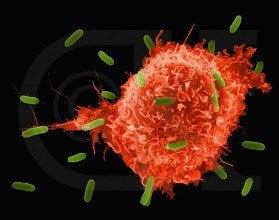
Biological weapons are very attractive to terrorists because they can be difficult to detect, are cost effective, and can be easy to use. Aerosols of biological agents are invisible, silent, odorless, tasteless, relatively easily dispersed, and they are 600 to 2000 times cheaper than other weapons of mass destruction. It has been estimated that the cost of a biological weapon is about 0.05 percent the cost of a conventional weapon to produce similar numbers of mass casualties per square kilometer. Production is comparatively easy, using common technology available for the production of some antibiotics, vaccines, foods, and beverages, and delivery systems such as spray devices from an airplane, boat, or car are commonly available.
Another appeal of biological agents for terrorists is the natural lead time provided by the organism's incubation period (3 to 7 days for most potential organisms), which allows terrorists to escape before an investigation by law enforcement or intelligence agencies could even begin. Apart from the use of an endemic infectious agent likely causing initial confusion because of the inability to differentiate a biological warfare attack from a natural epidemic, for some agents, the potential exists for secondary or tertiary transmission by person-to-person transmission or natural vectors. For these reasons, biological weapons have become a new weapon of choice for virtual terrorists, who seek to acquire toxic pathogens or their ingredients online.
Scientists are concerned that a technique called Clustered, Regularly Interspaced, Short Palindromic Repeat (CRISPR) is now so cheap and widely available that amateurs will start experimenting at home or in school labs. The technique works like genetic scissors to cut away DNA code and replace it with new genes. It has been hailed as one the most significant scientific breakthroughs in recent years, but there are fears that in the wrong hands, the procedure could unleash dangerous strains of bacteria or other organisms. Kits to make E.coli resistant to antibiotics are already for sale on the Internet.
The comparatively low cost and ease of use of the CRISPR system (which is a naturally-occurring defence mechanism used by bacteria) has made it feasible for a greater range of users beyond those who would ordinarily make use of the techniques of molecular biology. Prior to CRISPR, editing DNA required sophisticated labs, years of experience, a PhD degree, and many thousands of dollars. Today the simple do-it-yourself CRISPR kits could enable virtual terrorists targeting the food supply chain to alter the avian influenza genome and engineer a large bird flu epidemic, similar to the 2009 H1N1 epidemic in Asia that affected not only poultry, but also other mammals, including human beings.
In 2002 CNN ran an exposé on Al-Qaeda’s (AQ’s) experiments with crude toxins and poisons, testing the lethality of cyanide creams, ricin, mustard, sarin, and botulinum. AQ associates infiltrated Turkey, Britain, Spain, Italy, France, Sweden, Germany, and other countries to begin coordinating and planning ricin and cyanide attacks via a loose association of cells. US government knowledge of the extent of the network grew from a handful of terrorists in one country to dozens of extremists in 30 countries. The Islamic State may also have access to weapons containing sarin nerve gas that remained in Syria, as well as mustard agents and nerve agent rockets from Iraq, and chemical materials leftover from Libya programs. While It is unclear how effective these agents would be after years of storage, they could still be usable.
In 2015, the Blue-Ribbon Study Panel on Biodefense issued a National Blueprint for Biodefense, calling for leadership and major reform to optimize efforts to combat the threat of bioterrorism. As if to emphasize the urgency of the threat, that same year, the annual report of the Federal Select Agent Program described 233 potential occupational exposures or releases of select biological agents and toxins outside of the primary barriers of biocontainment in the US. Since 2001, the US government allocated $6 billion to research the threats, which pales in comparison to the amount spent on cybersecurity, airport screening, or border security. Of 46 items the Blueprint recommended for action in the first year following release of the report, partial progress had been made toward only 17 of them, and only 2 had been completed as of 2016.
A verification system could diminish the risk of terrorist acquisition of biological agents, given the ever-present possibility of deliberate acts of sabotage or terrorism. A lone actor terrorist or a disgruntled employee with knowledge of the operations of chemical plants or laboratories -- having become acquainted with safety and security procedures -- could exploit existing vulnerabilities in order to smuggle deadly pathogens out of the facility. It has been estimated that up to 95 percent of incidents related to security-related breaches were the result of insiders who were already employed and/or had a security clearance.
The ability to acquire key ingredients via the Internet, and to ‘hire’ individuals with the scientific knowledge to make biological weapons, means that bioterrorism is, and will remain, an omnipresent risk. With the stakes as high as they are, common sense dictates that businesses and governments must combine their resources to find more effective ways to battle the scourge of Virtual Terrorism. Fully implementing the Blueprint would be an excellent place to start.
*Daniel Wagner is author of the new book “Virtual Terror”, founder of Country Risk Solutions, and managing director of Risk Cooperative.
